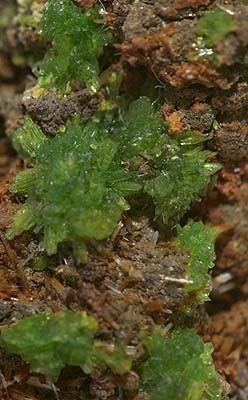Category Sulfate mineral Dana classification 31.8.2.1 | Formula(repeating unit) Cu[UO2(OH)SO4]2·8H2O Crystal system Triclinic | |
 | ||
Strunz classification 7.EB.05 (10 ed)VI/D.21-10 (8 ed) Crystal class Pinacoidal (1)(same H-M symbol) | ||
Johannite is a rare uranium sulfate mineral. It crystallizes in the triclinic crystal system with the chemical composition Cu[UO2(OH)SO4]2·8H2O. It crystallizes in the triclinic system and develops only small prism or thin to thick tabular crystals, usually occurs as flaky or spheroidal aggregates and efflorescent coatings. Its color is emerald-green to apple-green and its streak is pale green.
Contents
Johannite is a strong radioactive mineral with a calculated activity of 87,501,143 Bq/g (to the comparison: natural potassium: 31.2 Bq/g).
Etymology and history
Johannite was first described in 1830 by Wilhelm Karl Ritter von Haidinger. It was named for Archduke John of Austria (1782–1859), the founder of the Landesmuseum Joanneum (Styria, Austria).
Occurrence
Johannite forms as secondary mineral by oxidation from uraninite as well as different other uranium minerals
Localities include Argentina, Czech Republic, France, Gabon, Germany, Greece, Italy, Switzerland, United Kingdom and the United States. Type locality is the “Elias Mine” in Jáchymov (Czech Republic).
Crystal structure
Johannite crystallizes in the triclinic crystal system in the space group P1 with the lattice parameters a = 8.92 Å, b = 9.59 Å, c = 6.84 Å; α = 110°, β = 111.98°, γ = 100.3° and one formula unit per unit cell.
